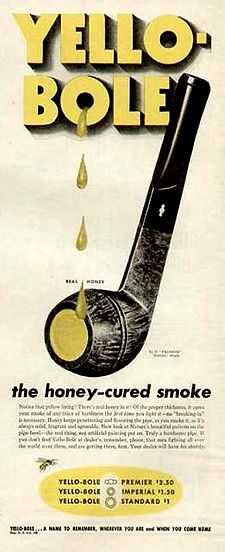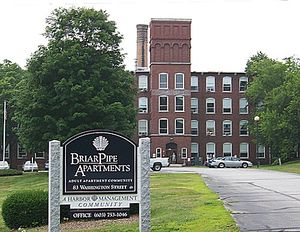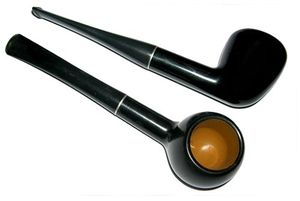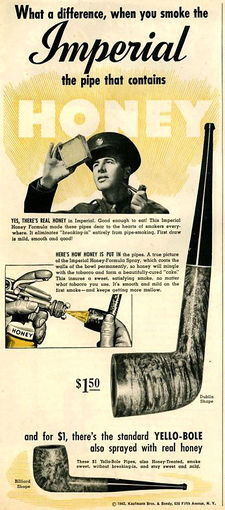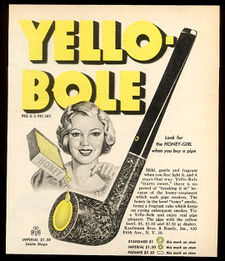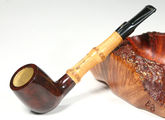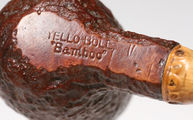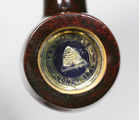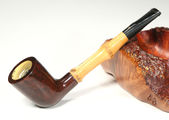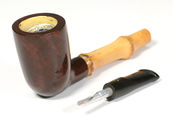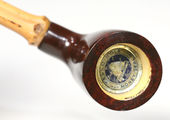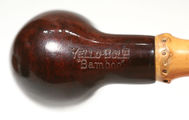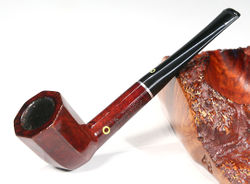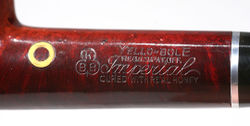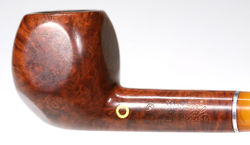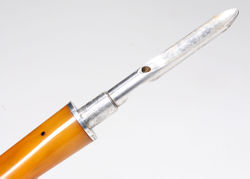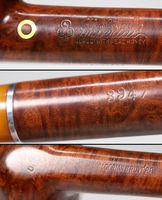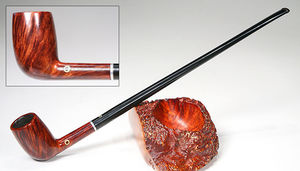Yello-Bole: Difference between revisions
No edit summary |
No edit summary |
||
| Line 2: | Line 2: | ||
In 1932 '''[[Kaufman Brothers & Bondy]]''' (KB&B), est. 1851, expanded their programm consisting of KB&B pipes, [[Reiss-Premier]] and [[Kaywoodie]] as the mainstay brand by introducing the '''Yello-Bole''' line. Yello- Bole was designed as an outlet for lower grade briar not used in Kaywoodie production. | In 1932 '''[[Kaufman Brothers & Bondy]]''' (KB&B), est. 1851, expanded their programm consisting of KB&B pipes, [[Reiss-Premier]] and [[Kaywoodie]] as the mainstay brand by introducing the '''Yello-Bole''' line. Yello- Bole was designed as an outlet for lower grade briar not used in Kaywoodie production. | ||
[[Image:Penacook_1.jpg|left|thumb|Penacook pipe factory; later a discount store and a residence for elders today]] | [[Image:Penacook_1.jpg|left|thumb|Penacook pipe factory; later a discount store and a residence for elders today]]At that time KB&B produced their brands in Union City and in West New York, both New Jersey. Deviating from that, Yello-Boles were manufactured by '''The New England Briar Pipe Company''' in Penacook, New Hampshire to use this KB&B subsidiary to capacity. | ||
At that time KB&B produced their brands in Union City and in West New York, both New Jersey. Deviating from that, Yello-Boles were manufactured by '''The New England Briar Pipe Company''' in Penacook, New Hampshire to use this KB&B subsidiary to capacity. | |||
As briar was hardly had during World War II, the KB&B Company embarked on a project of domestically grown briar wood, called Mission Briar or manzanita early in 1941. The '''Pacific Briarwood Company''', a subsidiary founded for this purpose, began harvesting the burls growing on the slopes of the Santa Cruz Mountains of California. Though this wood is botanically the same as briar form the Mediterranean countries, the smoking characteristics were not quite as good and the project was abandoned after the war. | As briar was hardly had during World War II, the KB&B Company embarked on a project of domestically grown briar wood, called Mission Briar or manzanita early in 1941. The '''Pacific Briarwood Company''', a subsidiary founded for this purpose, began harvesting the burls growing on the slopes of the Santa Cruz Mountains of California. Though this wood is botanically the same as briar form the Mediterranean countries, the smoking characteristics were not quite as good and the project was abandoned after the war. | ||
| Line 13: | Line 12: | ||
From the time of S.M. Frank's purchase in 1955 until 1972 Yello-Bole was run as a separate company, as division of the parent. Through this period, Yello-Bole, same as Kaywoodie, had it's own officers, sales force and maintained the production facilities in West New York. These 17 years were probably the most glorious years in Yello-Bole's history. | From the time of S.M. Frank's purchase in 1955 until 1972 Yello-Bole was run as a separate company, as division of the parent. Through this period, Yello-Bole, same as Kaywoodie, had it's own officers, sales force and maintained the production facilities in West New York. These 17 years were probably the most glorious years in Yello-Bole's history. | ||
[[Image:Ybole_09.jpg|left|thumb|Brylon pipe Ebony line]] | [[Image:Ybole_09.jpg|left|thumb|Brylon pipe Ebony line]][[File:YBShankLogo16.jpg|thumb|225px|Ad, courtesy Doug Valitchka]][[File:Yello bole1947 ad.jpg|thumb|225px|1947 Ad featuring the "Honey-Girl", courtesy Doug Valitchka]]In 1966 S.M. Frank had developed a synthetic material called '''Brylon''' as a cheaper alternative to briar. This material was immediatly used for Yello-Bole pipes, and millions of these pipes have been sold in the decades since then. They continue to be part of the Yello-Bole and Medico brands. At the moment Yello- Bole offers | ||
In 1966 S.M. Frank had developed a synthetic material called '''Brylon''' as a cheaper alternative to briar. This material was immediatly used for Yello-Bole pipes, and millions of these pipes have been sold in the decades since then. They continue to be part of the Yello-Bole and Medico brands. At the moment Yello- Bole offers | |||
* 4 lines of Brylon pipes: Ebony, Nova, Burley and Standard (Prices $15.95 - $18.95) and | * 4 lines of Brylon pipes: Ebony, Nova, Burley and Standard (Prices $15.95 - $18.95) and | ||
* 4 lines of Briar pipes: Spartan, Pug, Checker and Imperial (Prices $19.95 - $24.95). | * 4 lines of Briar pipes: Spartan, Pug, Checker and Imperial (Prices $19.95 - $24.95). | ||
| Line 27: | Line 25: | ||
The Yello Bole Aristocrat Airograte: An Aluminum and wood pipe with a twist. This pipe doesn't have a bowl per say, but more a briar cylinder that screws into the base of the body. At the bottom of the bowl is a metal grate, thus allowing air to be pulled through all the tobacco and reducing any chance of clogging. The lower bowl catches all moisture and tar reducing bite. These pipes can be had in a silver/chrome finish as well as a soft gold finish. The stem of these pipes has cooling fins up each side, and can be found in a straight or bent form. | The Yello Bole Aristocrat Airograte: An Aluminum and wood pipe with a twist. This pipe doesn't have a bowl per say, but more a briar cylinder that screws into the base of the body. At the bottom of the bowl is a metal grate, thus allowing air to be pulled through all the tobacco and reducing any chance of clogging. The lower bowl catches all moisture and tar reducing bite. These pipes can be had in a silver/chrome finish as well as a soft gold finish. The stem of these pipes has cooling fins up each side, and can be found in a straight or bent form. | ||
*You may also enjoying listening to Brian Levine's interview of S. M. Frank president, Bill Feuerbach, on the [http://pipesmagazine.com/blog/radio-talk-show/the-pipes-magazine-radio-show-episode-174/ Pipes Magazine Radio Show] | ===Bamboo Pipes=== | ||
Yello Bole also had a line of Bamboo pipes at one point. | |||
<center><gallery widths=200px caption="Examples of Yello-Bole Bamboo models, details, and nomenclature, courtesy Doug Valitchka"> | |||
File:YBBambooBilliard01.jpg | |||
File:YBBamboo07.jpg | |||
File:YBBamboo13.jpg | |||
File:YBBambooDublin01.jpg | |||
File:YBBambooDublin07.jpg | |||
File:YBBambooDublin08.jpg | |||
File:YBBambooDublin09.jpg | |||
File:Yello-Bole Bamboo2.jpg | |||
</gallery></center> | |||
<center><gallery perrow=3 widths=250px heights=200px caption="Examples of Yello-Bole Imperial Model with Shank Logo, details, and nomenclature, courtesy Doug Valitchka"> | |||
File:YBShankLogo01.jpg | |||
File:YBShankLogo05.jpg | |||
File:YBShankLogo05b.jpg | |||
File:YBShankLogo07.jpg | |||
File:YBShankLogo09.jpg | |||
</gallery></center> | |||
[[File:YBShankLogoChurch01.jpg|thumb|Shank logo Churchwarden, courtesy Doug Valitchka]]*You may also enjoying listening to Brian Levine's interview of S. M. Frank president, Bill Feuerbach, on the [http://pipesmagazine.com/blog/radio-talk-show/the-pipes-magazine-radio-show-episode-174/ Pipes Magazine Radio Show] | |||
'''[http://www.smfrankcoinc.com/ybmd/yellobole/yellobolepipes.htm Yello-Bole]''' | '''[http://www.smfrankcoinc.com/ybmd/yellobole/yellobolepipes.htm Yello-Bole]''' | ||
Revision as of 01:04, 19 May 2016
In 1932 Kaufman Brothers & Bondy (KB&B), est. 1851, expanded their programm consisting of KB&B pipes, Reiss-Premier and Kaywoodie as the mainstay brand by introducing the Yello-Bole line. Yello- Bole was designed as an outlet for lower grade briar not used in Kaywoodie production.
At that time KB&B produced their brands in Union City and in West New York, both New Jersey. Deviating from that, Yello-Boles were manufactured by The New England Briar Pipe Company in Penacook, New Hampshire to use this KB&B subsidiary to capacity.
As briar was hardly had during World War II, the KB&B Company embarked on a project of domestically grown briar wood, called Mission Briar or manzanita early in 1941. The Pacific Briarwood Company, a subsidiary founded for this purpose, began harvesting the burls growing on the slopes of the Santa Cruz Mountains of California. Though this wood is botanically the same as briar form the Mediterranean countries, the smoking characteristics were not quite as good and the project was abandoned after the war.
Was it for that reason? Advertising from the 1940's pictures the Yello-Bole "Honey Girl", who gently urges the pipe smoker to smoke the pipe with "a little honey in every bowl." In fact, honey was an ingredient of the material used to coat the inside of the bowl. It was said to provide a faster, sweeter break-in of the pipe.
In 1952, 101 years after the Kaufman brothers had opened a small pipe shop in the Bowery section of New York City, Kaufman Brothers & Bondy Company with all subsidiaries was purchased by an unknown company strange to pipe industry. (At least, the new owner was economical because the KB&B managers had to leave their luxurious bureaus on 630 Fifth Avenue, New York - the Rockefeller Center - for new rooms in the factory on 6400 Broadway, West New York.) This interlude ended after only 3 years in March of 1955, when S.M. Frank & Co. Inc. bought Kaufman Brothers & Bondy, The Kaywoodie Company, Reiss-Premier Corp., The New England Briar Pipe Co. and - of course - Yello-Bole.
From the time of S.M. Frank's purchase in 1955 until 1972 Yello-Bole was run as a separate company, as division of the parent. Through this period, Yello-Bole, same as Kaywoodie, had it's own officers, sales force and maintained the production facilities in West New York. These 17 years were probably the most glorious years in Yello-Bole's history.
In 1966 S.M. Frank had developed a synthetic material called Brylon as a cheaper alternative to briar. This material was immediatly used for Yello-Bole pipes, and millions of these pipes have been sold in the decades since then. They continue to be part of the Yello-Bole and Medico brands. At the moment Yello- Bole offers
- 4 lines of Brylon pipes: Ebony, Nova, Burley and Standard (Prices $15.95 - $18.95) and
- 4 lines of Briar pipes: Spartan, Pug, Checker and Imperial (Prices $19.95 - $24.95).
All Yello-Bole pipes feature push bits with scoop.
In 1972, S.M. Frank constructed a new building to serve as production facility and corporate offices on Horse Block Road, Yapank, Long Island, and around the same time S.M. Frank's pipe brands started appearing in catalogs together.
Yello-Bole's more recent history was subjected to the same processes as S.M. Frank's other brands. For a detailed description see the S.M. Frank article, please. All briar Kaywoodie, Yello-Bole, and Medico pipes, as well as private label pipes, are produced at the manufacturing facility in Tampa, Florida today. All Brylon pipes are manufactured in Peekskill, NY.
Metal Pipes
The Yello Bole Aristocrat Airograte: An Aluminum and wood pipe with a twist. This pipe doesn't have a bowl per say, but more a briar cylinder that screws into the base of the body. At the bottom of the bowl is a metal grate, thus allowing air to be pulled through all the tobacco and reducing any chance of clogging. The lower bowl catches all moisture and tar reducing bite. These pipes can be had in a silver/chrome finish as well as a soft gold finish. The stem of these pipes has cooling fins up each side, and can be found in a straight or bent form.
Bamboo Pipes
Yello Bole also had a line of Bamboo pipes at one point.
- Examples of Yello-Bole Bamboo models, details, and nomenclature, courtesy Doug Valitchka
- Examples of Yello-Bole Imperial Model with Shank Logo, details, and nomenclature, courtesy Doug Valitchka
*You may also enjoying listening to Brian Levine's interview of S. M. Frank president, Bill Feuerbach, on the Pipes Magazine Radio Show
Yello-Bole S. M. Frank & Co. Inc. 1000 N. Division Street Peekskill, NY 10566 E-mail: smfrankco@aol.com
